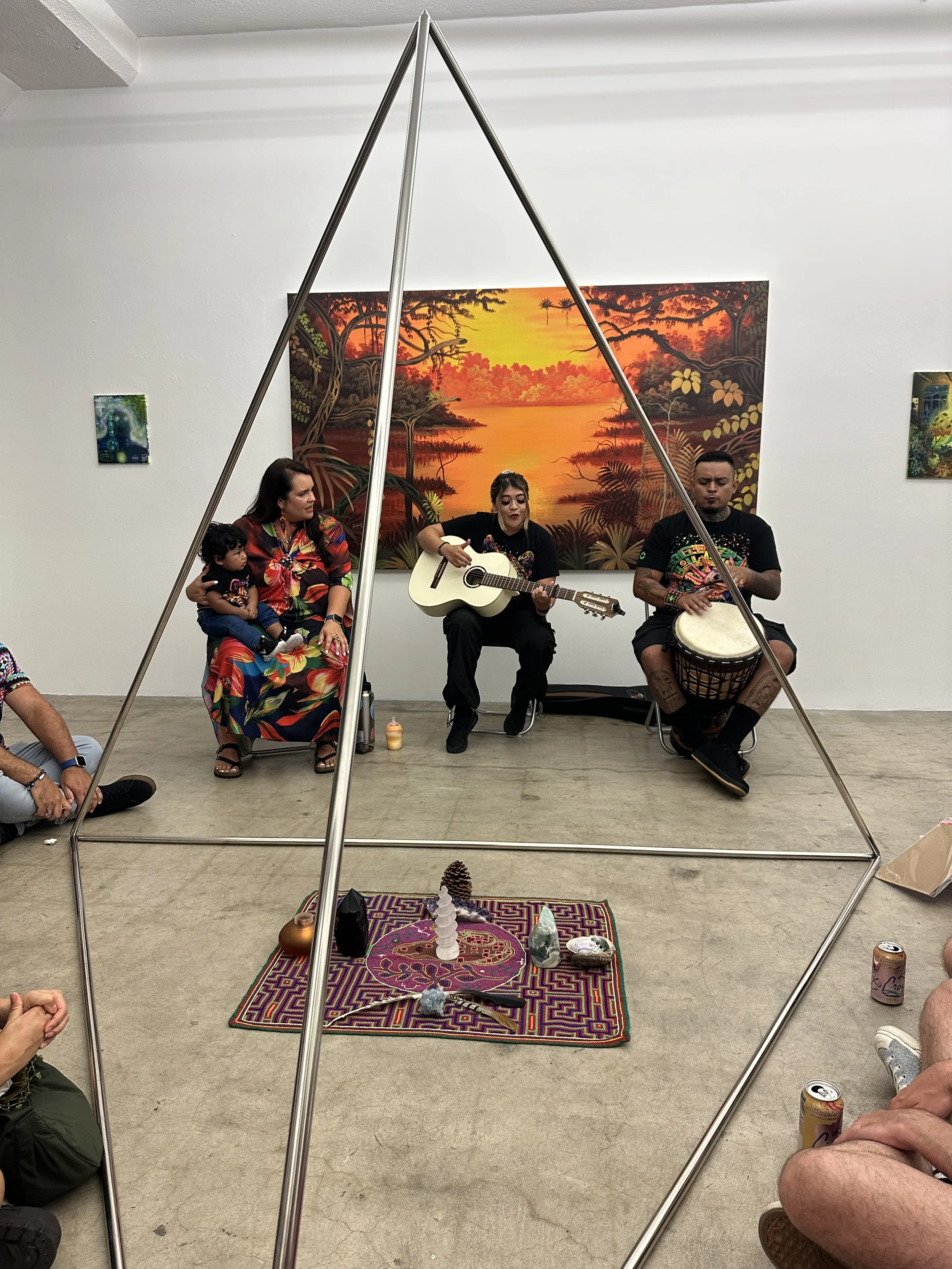From left: Kathryn Garcia The Feminine Void, 2025, Colored pencil on Stonehenge 48 x 36 inches Limbert Gonzalez Camino del Jaguar, 2025 Acrylic on Canvas 32 x 24 inches.
LOS ANGELES
EL PORTAL
Jul 12 - Sep 7, 2025
Opening Reception: Sat, Jul 12, 7-10 pm
Performances: Sat, Jul 12, 8 pm & Sat, Aug 16, 7:30 pm
-
Tiger Strikes Asteroid Los Angeles te invita a entrar en EL PORTAL, una exposición transdisciplinaria de seis artistas visuales y cinco de performance, cuyo trabajo explora la trascendencia y la transformación a través del uso de la ayahuasca, "la medicina", la ceremonia y el ritual. EL PORTAL explora aspectos clave de la experiencia visionaria a través de la pintura, dibujo, escultura y performance. La ayahuasca, cariñosamente conocida como "El Espíritu Abuela" por las culturas indígenas, proporciona tanto la inspiración como el punto de partida para el trabajo en esta exposición.
La Ayahuasca es un té amargo que se elabora a partir de las hojas de la planta Chacruna y la vid de Ayahuasca, que se encuentran en la selva amazónica. No se considera una droga en el sentido tradicional, sino un sacramento sagrado para las culturas indígenas que lo utilizaron por su potencial enteogénico/espiritual. Para los chamanes amazónicos es una "tecnología" que ofrece la oportunidad de crear un contacto directo con la inteligencia del mundo vegetal. A través de una cuidadosa guía de chamanes entrenados, los participantes en las ceremonias de ayahuasca pueden establecer caminos energéticos hacia una sabiduría atemporal que no es humana, y tal vez no de origen terrenal, pero que está inseparablemente arraigada en la sabiduría de la selva amazónica.
Hoy en día, un gran número de practicantes de más allá de la Amazonía están experimentando la ayahuasca y los profundos cambios personales, sociales y ecológicos que insta a realizar. Entre las innumerables ideas que las personas experimentan respecto a la transformación personal en la medicina, un mensaje que a menudo llega es el llamado a sanar el planeta y proteger el medio ambiente. Los artistas a menudo se ven obligados a producir obras que dan testimonio de la profunda belleza y el potencial transformador de la experiencia de la ayahuasca, un mensaje que comienza en el corazón y viaja a las mentes de los demás, llamando a una sanación e iluminación planetaria.
Aunque no todos los artistas en la exposición han trabajado con la ayahuasca, todos comparten un interés en la medicina y el arte visionario. El arte siempre ha sido un portal y vehículo para el crecimiento y la transformación espiritual pero, con la ayahuasca, los humanos rara vez han encontrado un aliado tan potente y consistente en la creación de una rica conexión creativa y gnóstica con el mundo natural. Aunque la exposición no está destinada a ser restringida solo al arte inspirado en la ayahuasca, habla de la idea más amplia del arte como un vehículo para abrir portales de conciencia y transformación, de la misma manera que la melodía ceremonial de un chamán (Ícaro) abre un portal a otra dimensión de curación y sabiduría.
EL PORTAL también contará con actuaciones musicales y ceremonias a lo largo de la exhibición destacando varias prácticas de ayahuasca y ceremoniales con presentaciones de Lauren Armstrong, Vicky Coronado, Kathryn García, Sean Noyce, y Gil Sandoval.
Acerca del trabajo
El trabajo de Kathryn García entra en diálogo con artistas visionarios como Hilma af Klint y Emma Kunz, quienes consideraban que sus prácticas eran formas de transmisión; vehículos para la inteligencia espiritual. Al igual que ellos, García no simplemente representa, sino que canaliza. Sus dibujos surgen de estados alterados de conciencia, ya sea contemplativa, somática o ceremonial. Sus dibujos y pirámides sirven de portales, tecnologías visuales y espaciales que nos permiten entrar en el vacío y volver renovados.
Limbert Gonzales es un artista visionario que vive y trabaja en la selva amazónica, cuyas pinturas de plantas, animales y espíritus de vivos colores dan vida a la convivencia encantada que se produce entre las tribus indígenas y su entorno. Limbert trabaja con la ayahuasca de manera regular en su vida diaria y la utiliza para canalizarla en sus pinturas. También es un maestro espiritual comprometido y eco-activista enseñando a los niños pequeños en la Amazonía a pintar con la finalidad de fomentar una relación protectora con la selva tropical y la ciudadanía global entre las generaciones futuras.
Aunque Sean Noyce no ha trabajado con la ayahuasca, exhibe un interés paralelo en el arte ceremonial y la magia popular, a veces llamada "medicina tradicional" por sus antepasados mormones. Gran parte del trabajo de Noyce apunta a la evolución, dilución y difusión de las prácticas chamánicas desde la frontera estadounidense hasta las tradiciones populares del norte de Europa.
Ian Patrick Cato es otro artista que no trabaja explícitamente sobre la ayahuasca, si embargo está profundamente interesado en la experiencia psicodélica representada a través de la pintura, así como en las diversas posibilidades transformadoras inherentes al chamanismo. Sus pinturas están ricamente estratificadas, creando un cuadro de imágenes transgénero con sello visionario. La forma en que sus pinturas confrontan al espectador en un miasma visual de múltiples capas refleja de muchas maneras los estados alterados y las visiones que uno podría experimentar en un viaje de ayahuasca.
Los artistas textiles shipibo de la exposición (Isabel Franchini y Flor Patricia Urguia Bardales) ofrecen la perspectiva y forma de trabajar indígena con la medicina para derivar imágenes. Para los shipibo, un pueblo indígena de la cuenca del Amazonas en Perú, la selva revela patrones geométricos de varias maneras que pueden representarse tanto visualmente como en poderosas canciones curativas (Ícaros). Cada textil de diseño intrincado es una partitura musical que se puede realizar en ceremonias de curación para proteger a los participantes como se puede experimentar en una ceremonia de Ayahuasca. Además, los ícaros y los textiles pueden ser las manifestaciones de las transmisiones espirituales que ocurren en las ceremonias o cuando los chamanes están trabajando directamente con las plantas en lo que llaman dietas.
Biografías
Kathryn García (nacida en Los Ángeles, CA) es una artista interdisciplinaria cuya práctica está arraigada en la devoción a lo sagrado femenino y el poder transformador del ritual. Trabajando a través de video, escultura, dibujo geométrico sagrado, rendimiento específico del sitio e instalación inmersiva, García crea templos contemporáneos, que son portales para la curación, el recuerdo y la presencia encarnada. Guiada por su práctica espiritual y peregrinaciones a sitios antiguos a lo largo del mundo, García integra el movimiento somático, las arquitecturas ceremoniales y el trabajo de memoria ancestral en su cuerpo de trabajo en evolución. Sus esculturas a menudo toman la forma de pirámides de acero inoxidable: vasos geométricos diseñados para la meditación, activación y resonancia colectiva. Tanto en contextos individuales como participativos, el trabajo de García invita a las audiencias a entrar en estados alterados de conciencia y comunión, difuminando el límite entre el espectador y el participante ritual.
Muchas veces sus esculturas toman la forma de acero inoxidable Pirámides: vasos geométricos diseñados para la meditación, activación y resonancia colectiva. Tanto en contextos individuales como participativos, el trabajo de García invita a las audiencias a entrar en estados alterados de conciencia y comunión, difuminando el límite entre el espectador y el participante ritual. Sus prácticas de video y dibujo exploran más a fondo estos temas: trazando narrativas míticas, estados de trance y rejillas cosmológicas a través del cuerpo y la línea. Ya sea filmado en paisajes sagrados o construidos desde dentro de ellos. Sus videos son devociones vivas: transmisiones de presencia, vulnerabilidad y conocimiento atemporal. El trabajo de García a menudo centra el cuerpo femenino como un recinto sagrado y fuerza generativa, reimaginando el arquetipo de la Diosa como un portal para la recuperación, soberanía espiritual y curación colectiva. Estas experiencias, ofrecidas a través del movimiento, el sonido, la forma y la quietud, despiertan la interconexión y restauran el cuerpo como un recipiente de inteligencia divina. Al inicio de su carrera, García colaboró internacionalmente con Emi Fontana y Rirkrit Tiravanija en proyectos emblemáticos como Women in the City (2008), Palm Pavilion (2008) y Asile Flottant (2010). Su trabajo ha sido ampliamente exhibido en EU y el extranjero, incluyendo Hauser & Wirth; Museo de Arte del Condado de Orange; LAXART; Varios Fuegos Pequeños; 356 Misión; Galería Gavlak (Los Ángeles); Galería Pace; GBE; Participant Inc; PS1-MoMA (Nueva York); Ballroom Marfa; The Power Station (Dallas); Nina Johnson (Miami); The Bunker Artspace (West Palm Beach); Edel Assanti y Southard Reid (Londres); Embajada (Puerto Rico); Arredondo/Arozarena (Ciudad de México), y Fundación DESTE (Grecia).
Artista visionario Limbert Gonzales Laulate (nacido en 1979, Yarinacocha-Ucayali, Perú) es un artista especializado en arte contemporáneo amazónico visionario, egresado de la Escuela de Pintura Amazónica Usko-Ayar. Limbert creció rodeado por la selva amazónica, donde el contacto e interacción con la naturaleza lo llevaron a interesarse por el arte amazónico. En 1992 conoció al maestro pintor visionario amazónico Pablo Amaringo, director y fundador de la escuela de pintura amazónica USKO-AYAR, quien lo reconoció como uno de sus discípulos por haber recibido sus enseñanzas filosóficas. Limbert Gonzales es un artista dedicado a enseñar pintura neoamazónica a niños y jóvenes de la selva peruana. En 2003 comenzó a pintar visiones de la ayahuasca y otras plantas medicinales. En 2013 fue reconocido a nivel nacional por el Instituto Nacional de Cultura.
@limbert_gonzales
facebook.com/limbert.gonzalesSean Noyce (nacido en 1979, Salt Lake City, UT) vive y trabaja en Los Ángeles y ha expuesto en galerías y museos de todo el mundo. Su trabajo se ha exhibido en Scope Art Show, Miami y Nueva York; Supermarket Art Fair, Estocolmo; SPRING/BREAK Art Show, LA; Franconia Sculpture Park, Schafer, MN; Galerie Pompom, Sydney, Australia; (e)merge Art Fair, Washington, D.C.; Texas Contemporary, Houston; QiPO, México, City; The San Diego Art Institute; Temple University, Roma; Torrance Art Museum; University of Colorado, Colorado Springs; Oxnard College; y Centro Cultural Snug Harbor, Staten Island. El trabajo de Noyce ha sido publicado en The Washington Post; Artforum; Fabrik Magazine; FULL BLEDE; New York Daily News; Playboy; Voyage LA; Only In Hollywood; y Flavorpill.
Ian Patrick Cato (nacido en 1991, Orange, CA) es un artista de Nashville, Los Ángeles.
Cato está fascinado por la borrosidad entre la realidad y la ficción en nuestro mundo actual. “Todas mis películas favoritas de ciencia ficción se están haciendo realidad”, dice. Viviendo en la capital de hacer creer, le gusta pintar "simulaciones" que se inspiran en la cultura pop de ciencia ficción y fantasía de su juventud, la estética de las calcomanías para camiones y de las defensas de vehículos en las autopistas así como los aspectos sobrenaturales de la naturaleza, que a menudo se pasan por alto. Utiliza el muestreo de estilo Gonzo para reinterpretar estas diferentes iconografías históricas; proyectando una amplia red de insignias enredadas a través del crepúsculo de un paisaje cultural estadounidense. A veces como mapas, otras como espejismos, el trabajo de Cato ofrece una perspectiva por excelencia en la matriz alucinatoria de la cultura contemporánea del sur de California. Cato recibió su BFA en 2015 de la Universidad de Tennessee, Knoxville, School of Art. Ha exhibido trabajos en Blum & Poe (2020) Los Ángeles, The Museum of Contemporary Art Tokyo (2019), Japan Over The Influence, en el stand de NADA NYC (2022), Space Ten (2021, 2022) Los Angeles Gallery, ALSO (2018, 2021, 2024) Los Ángeles, y Modest Common (2024) Los Ángeles.
Isabel Franchini es una artista textil shipibo que vive en el área de Yarinacocha de Pucallpa, Perú.
Flor Patricia Urguia Bardales es una artista textil shipibo que reside en la Comunidad Nativa San Francisco, una de las comunidades shipibo más antiguas y grandes de la región de Ucayali en el centro de la Amazonía peruana.
Vicky Coronado y Gil Sandoval son ceremonialistas que tocan música medicinal y realizan ceremonias de cacao y ambil. Su negocio, Viva La Vida, vende ambil, chilcuague y camisetas bellamente diseñadas. Residen en Boyle Heights con su bebé, Ramses.
Lauren Armstrong (nacida en 1979, Portland, Oregón) es una cantante, compositora y ceremonialista. Tiene licenciatura en teatro de la Universidad de Oregón y maestría en Bellas Artes en actuación de la Universidad de Iowa. Ha entrenado con chamanes y portadores de medicinas de Perú, Brasil, Ecuador y Hawái. Más recientemente ha ayudado a facilitar ceremonias de ayahuasca con la tribu Yawanawa de la Amazonía brasileña. Esta es su primera colaboración curatorial oficial con Tiger Strikes Asteroid Los Angeles.
Tiger Strikes Asteroid Los Angeles invites you to enter EL PORTAL, a transdisciplinary exhibition of 6 visual artists and 5 performance artists, whose work explores transcendence and transformation through the use of ayahuasca, “the medicine”, ceremony, and ritual. EL PORTAL explores key aspects of the visionary experience through painting, drawing, sculpture, and performance. Affectionately referred to as “The Grandmother Spirit” by indigenous cultures, ayahuasca provides both the inspiration and departure point for the work in this exhibition.
Ayahuasca is a bitter tea that is made from brewing the leaves of the Chacruna plant and the Ayahuasca vine, both of which are found in the Amazon rainforest. It is not considered a drug in the traditional sense, but a sacred sacrament by the indigenous cultures that utilized it for its entheogenic/spiritual potential. For Amazonian shamans it is a “technology” that provides opportunities for direct contact with the intelligence of the plant world. Through careful guidance by trained shamans participants in ayahuasca ceremonies are able to establish energetic pathways to a timeless wisdom that is non-human — and perhaps not of earthly origin — yet inseparably rooted in the wisdom of the Amazonian jungle.
Today, practitioners in large numbers from beyond the Amazon are experiencing ayahuasca and the profound personal, societal, and ecological changes it is urging us to make. Among the countless insights that people experience regarding personal transformation on the medicine, one message that often comes through is the calling to heal the planet and protect the natural environment. Artists are often compelled to produce work that bears witness to the profound beauty and transformative potential of the ayahuasca experience — a message that begins in the heart and travels to the minds of others, calling for a planetary healing and enlightenment.
Although not all of the artists in the exhibition have worked with ayahuasca, they all share an interest in the medicine and visionary art. Art has always been a portal and vehicle for spiritual growth and transformation, but with ayahuasca, humans have rarely found such a potent and consistent ally in creating a rich creative and gnostic connection to the natural world. Although the exhibition is not meant to be restricted to only ayahuasca-inspired art, it speaks to the larger idea of art as a vehicle for opening portals of consciousness and transformation — in the same way that a shaman’s ceremonial melody (Icaro) opens a portal to another dimension of healing and wisdom.
EL PORTAL will also feature musical performances and ceremonies throughout the run of the exhibition highlighting various ayahuasca and ceremonial practices with performances by Lauren Armstrong, Vicky Coronado, Kathryn Garcia, Sean Noyce, and Gil Sandoval.
Performance & Event Details:
Sat, Jul 12 - TSA Main Gallery / 5th floor
8 pm Medicine songs and Pachacuti Mesa ceremony led by Lauren Armstrong, Vicki Coronado, and Gil Sandoval
Fri, Aug 8 - online video release in conjunction with the Lion’s Gate Portal—a powerful cosmic alignment when the Sun meets Sirius and the energies of transformation, remembrance, and spiritual awakening are amplified.
8 pm Blood Moon, 2025
A film by Kathryn Garcia, Soundtrack by Christina Gaillard
Sat, Aug 16 - Bendix rooftop / 11th floor
7:30 pm Medicine music ceremonial performance by Lauren Armstrong
8:30 pm The Resurrection of Stars ceremonial performance by Sean Noyce
9:00 pm Blood Moon by Kathryn Garcia Screening
About the work
Kathryn Garcia’s work enters into dialogue with visionary artists such as Hilma af Klint and Emma Kunz, both of whom considered their practices to be forms of transmission—vehicles for spiritual intelligence. Like them, Garcia does not simply depict, she channels. Her drawings emerge from altered states of awareness—whether contemplative, somatic, or ceremonial. Her drawings and pyramids serve as portals: visual and spatial technologies that allow us to enter the void and return renewed.
Limbert Gonzales is a visionary artist living and working in the Amazon jungle whose vividly colorful paintings of plants, animals, and spirits bring to life the enchanted coexistence that occurs between indigenous tribes and their surroundings. Limbert works with ayahuasca on a regular basis in his daily life and uses it to channel his paintings. He is also a committed spiritual teacher and eco-activist teaching young children in the Amazon to paint as a way of fostering a protective relationship with the rainforest and global citizenship among future generations.
Although Sean Noyce has not worked with ayahuasca, he exhibits parallel interest in ceremonial performance art and folk magic, sometimes called “traditional medicine” by his Mormon ancestors. So much of Noyce’s work points to the evolution, dilution, and dissemination of shamanic practices from the American frontier to Northern European folk traditions.
Ian Patrick Cato is another artist who does not make work explicitly about ayahuasca, but is deeply interested in the psychedelic experience as represented through painting as well as the various transformative possibilities inherent in shamanism. His paintings are richly layered, creating a trans-like tableau of imagery that feels truly visionary. The way his paintings confront the viewer in a multilayered visual miasma in many ways mirrors the altered states and visions that one might experience on an ayahuasca journey.
The Shipibo textile artists in the exhibition (Isabel Franchini and Flor Patricia Urguia Bardales) offer the indigenous perspective and way of working with the medicine to derive images. For the Shipibo, an indigenous people from the Amazon basin in Peru, the jungle reveals geometric patterns in various ways that can be represented both visually and as powerful healing songs (Icaros). Each intricately designed textile is a musical score that can be performed in healing ceremonies to protect the participants as one may experience in an Ayahuasca ceremony. Furthermore, the Icaros and textiles can be the manifestations of spiritual transmissions that occur in the ceremonies or when the shamans are working directly with the plants in what are called “dietas” (diets).
If you would like to support Limbert Gonzales’s effort to teach neo-Amazonian painting free of charge to the children and young people of the Peruvian Amazon please click the button to make a direct donation.
Kathryn Garcia (b. Los Angeles, CA) is an interdisciplinary artist whose practice is rooted in devotion to the sacred feminine and the transformative power of ritual. Working across video, sculpture, sacred geometric drawing, site-specific performance, and immersive installation, Garcia creates contemporary temples—portals for healing, remembrance, and embodied Presence. Guided by her spiritual practice and pilgrimages to ancient sites across the globe, Garcia integrates somatic movement, ceremonial architectures, and ancestral memory work into her evolving body of work. Her sculptures often take the form of stainless steel pyramids—geometric vessels designed for meditation, activation, and collective resonance. In both solo and participatory contexts, Garcia's work invites audiences to enter altered states of awareness and communion, blurring the boundary between viewer and ritual participant. Her video and drawing practices further explore these themes—tracing mythic narratives, trance states, and cosmological grids through the body and line. Whether filmed at sacred landscapes or constructed from within them, Garcia’s videos are living devotions—transmissions of presence, vulnerability, and timeless knowing. Garcia’s work often centers the female body as a sacred site and generative force, reimagining the Goddess archetype as a portal for reclamation, spiritual sovereignty, and collective healing. These experiences—offered through movement, sound, form, and stillness—awaken interconnectedness and restore the body as a vessel of divine intelligence. Early in her career, Garcia collaborated internationally with Emi Fontana and Rirkrit Tiravanija on landmark projects such as Women in the City (2008), Palm Pavilion (2008), and Asile Flottant (2010). Her work has been exhibited widely in the U.S. and abroad, including Hauser & Wirth; the Orange County Museum of Art; LAXART; Various Small Fires; 356 Mission; Gavlak Gallery (Los Angeles); Pace Gallery; GBE; Participant Inc; PS1-MoMA (New York); Ballroom Marfa; The Power Station (Dallas); Nina Johnson (Miami); The Bunker Artspace (West Palm Beach); Edel Assanti and Southard Reid (London); Embajada (Puerto Rico); Arredondo/Arozarena (Mexico City); and the DESTE Foundation (Greece).
@bbydbl
Visionary Artist Limbert Gonzales Laulate (b. 1979, Yarinacocha-Ucayali, Peru) is an artist specialized in visionary Amazonian contemporary art, graduated from the School of Painting. Amazonian Usko-Ayar, Limbert grew up surrounded by the Amazon rainforest, where contact and interaction with nature led him to become interested in Amazonian art. In 1992 he met the master visionary Amazonian painter Pablo Amaringo, Director and founder of the Amazonian painting school USKO-AYAR who recognized him as one of his disciples for receiving his philosophical teachings. Limbert Gonzales is an artist who is dedicated to teaching neo-Amazonian painting to children and young people in the Peruvian jungle. In 2003 he began to paint visions of ayahuasca and other medicinal plants. In 2013 he was. recognized nationally by the National Institute of Culture.
@limbert_gonzales
facebook.com/limbert.gonzales
Sean Noyce (b. 1979, Salt Lake City, UT) lives and works in Los Angeles and has exhibited in galleries and museums around the globe. His work has been exhibited at Scope Art Show, Miami and New York; Supermarket Art Fair, Stockholm; SPRING/BREAK Art Show, LA; Franconia Sculpture Park, Schafer, MN; Galerie Pompom, Sydney, Australia; (e)merge Art Fair, Washington, D.C.; Texas Contemporary, Houston; QiPO, Mexico, City; The San Diego Art Institute; Temple University, Rome; Torrance Art Museum; University of Colorado, Colorado Springs; Oxnard College; and the Snug Harbor Cultural Center, Staten Island. Noyce’s work has been featured in The Washington Post; Artforum; Fabrik Magazine; FULL BLEDE; New York Daily News; Playboy; Voyage LA; Only In Hollywood; and Flavorpill.
Ian Patrick Cato (b. 1991, Orange, CA) is a Nashville raised, Los Angeles based artist. Cato is fascinated by the blurriness between reality and fiction in our present world. -“All my favorite sci-fi movies are coming true!” Living in the capital of make believe, he likes painting ‘simulations’ that draw inspiration from the science fiction & fantasy pop culture of his youth, the aesthetics of trucking decals & bumper stickers out on the freeways, and the often overlooked supernatural aspects of nature. He uses Gonzo style sampling to reinterpret these different historical iconographies; casting a wide net of spangled insignia across the dusk of an American cultural landscape. Sometimes like maps, other times more like mirages, Cato’s work offers a quintessential perspective into the hallucinatory matrix of contemporary Southern California culture. Cato received his BFA in 2015 from the University of Tennessee, Knoxville, School of Art. He has exhibited work at Blum & Poe (2020) Los Angeles, The Museum of Contemporary Art Tokyo (2019) Japan, Over The Influence booth at NADA NYC (2022), Space Ten (2021, 2022) Los Angeles, Gallery ALSO (2018, 2021, 2024) Los Angeles, and Modest Common (2024) Los Angeles.
Isabel Franchini is a Shipibo textile artist living in the Yarinacocha area of Pucallpa, Peru.
Flor Patricia Urguia Bardales is a Shipibo textile artist who resides in the Comunidad Nativa San Francisco which is one of the oldest and largest Shipibo communities in the Ucayali region in the center of the Peruvian Amazon.
Vicky Coronado and Gil Sandoval are ceremonialists who play medicine music and hold cacao and ambil ceremonies. Their business, Viva La Vida, sells ambil, chilcuague, and beautifully designed t-shirts. They reside in Boyle Heights with their baby, Ramses.
Lauren Armstrong (b. 1979, Portland, OR) is a singer, song writer, and ceremonialist. She has a Bachelor's Degree in Theater from the University of Oregon and a Master of Fine Arts in Acting from the University of Iowa. She has trained with shamans and medicine carriers from Peru, Brazil, Ecuador and Hawai’i. Most recently she has assisted in facilitating ayahuasca ceremonies with the Yawanawa tribe from the Brazilian Amazon. This is her first official curatorial collaboration with Tiger Strikes Asteroid Los Angeles.
Click to view a digital handout about the artists in EL PORTAL.


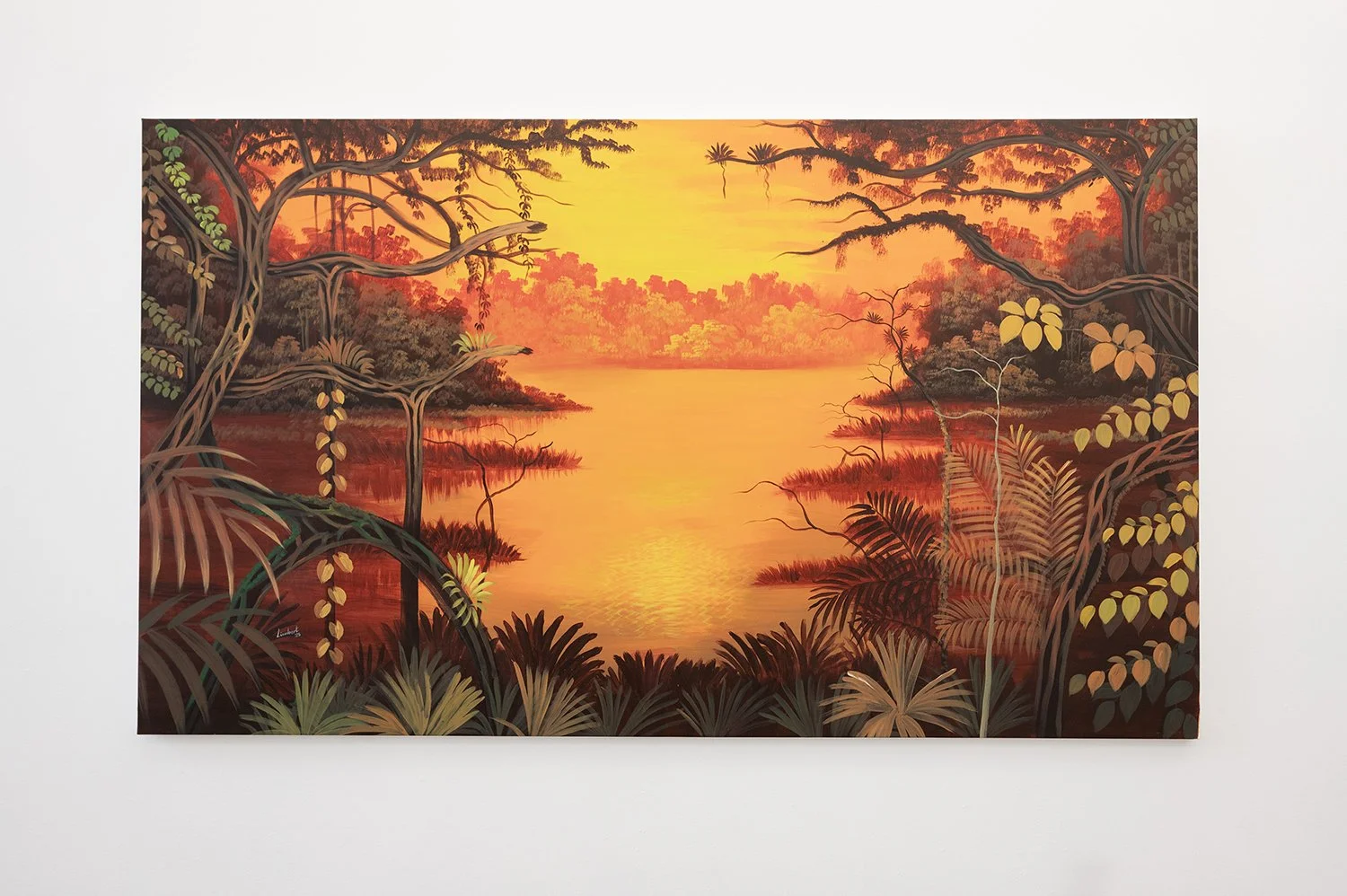


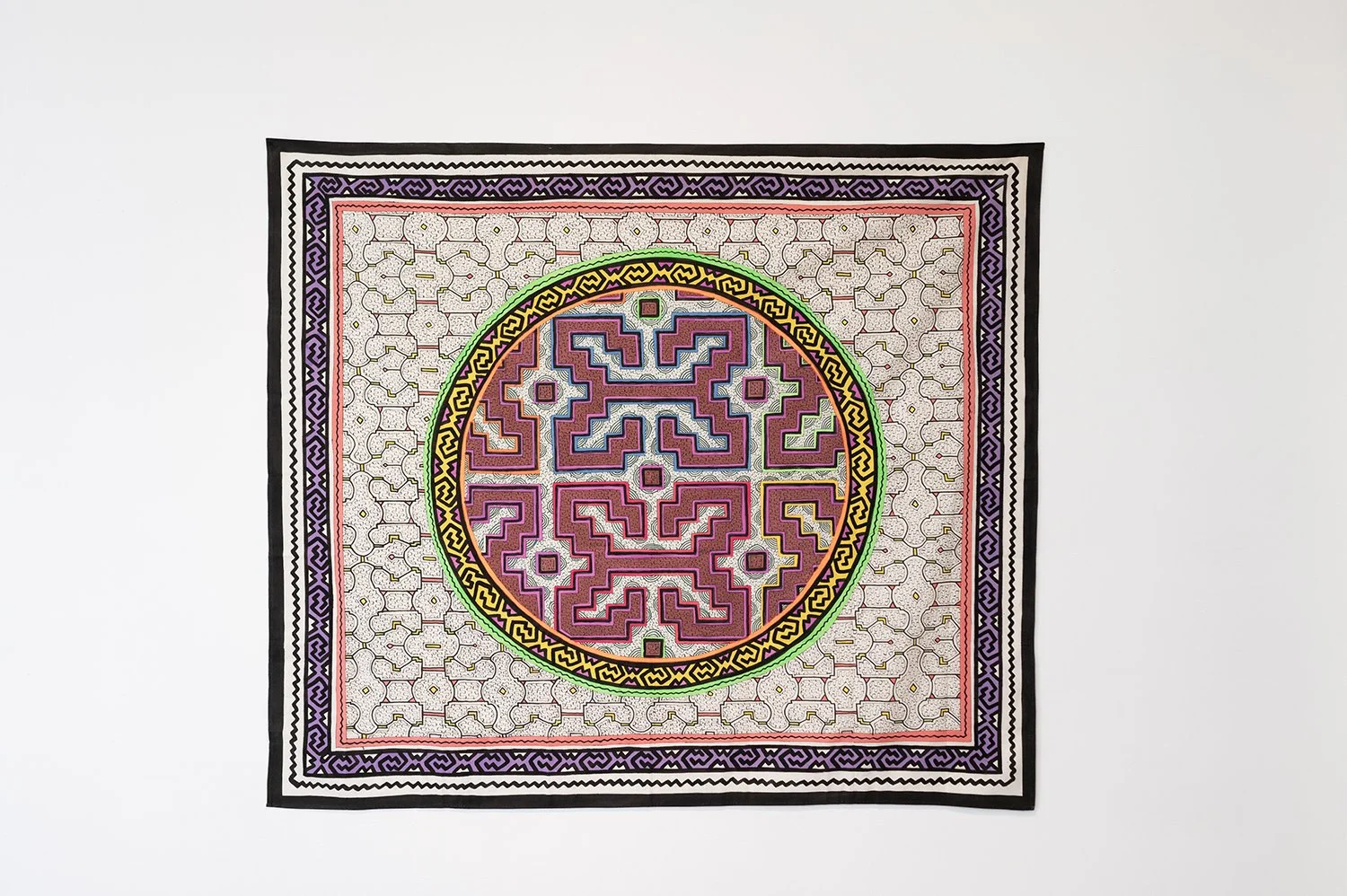





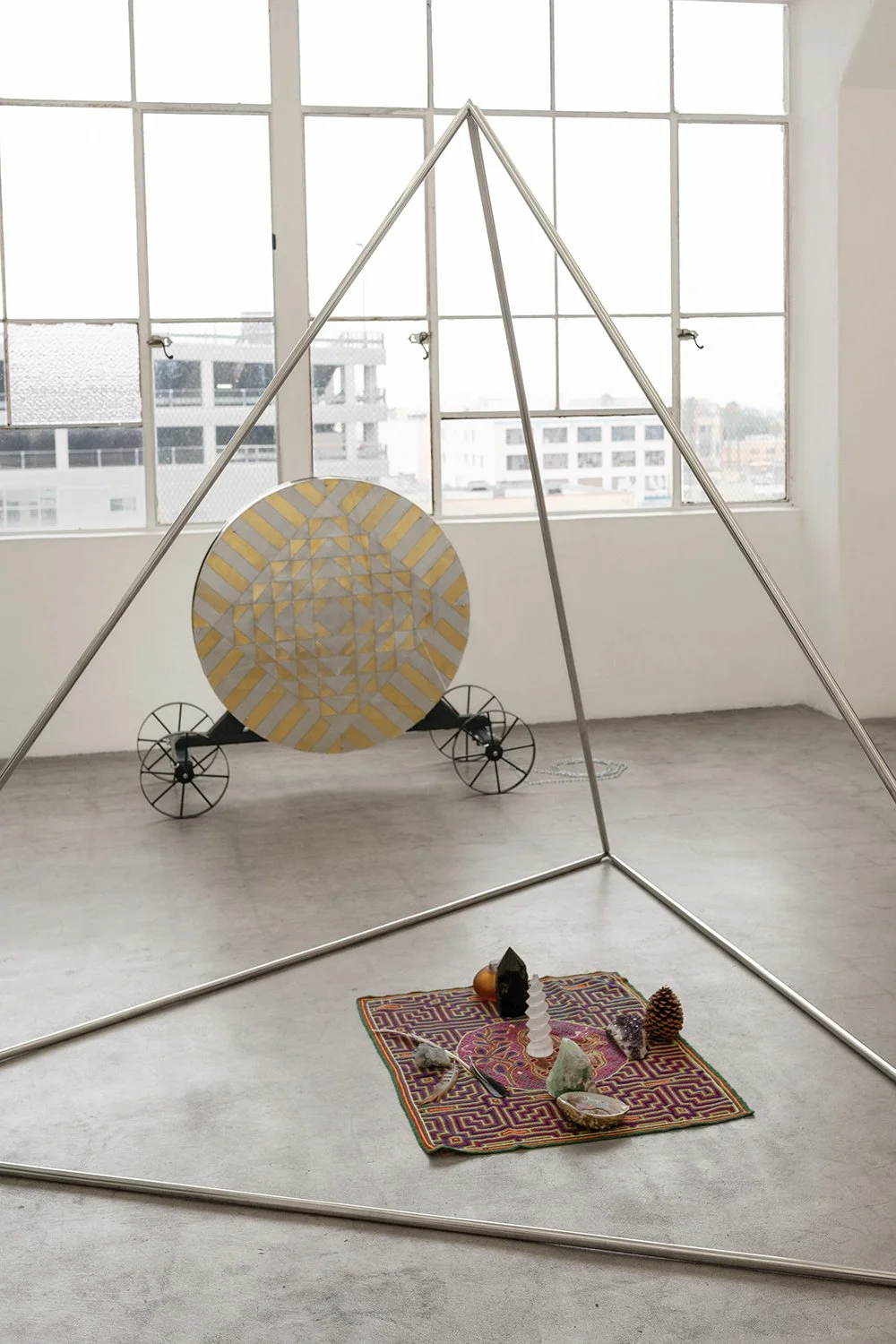

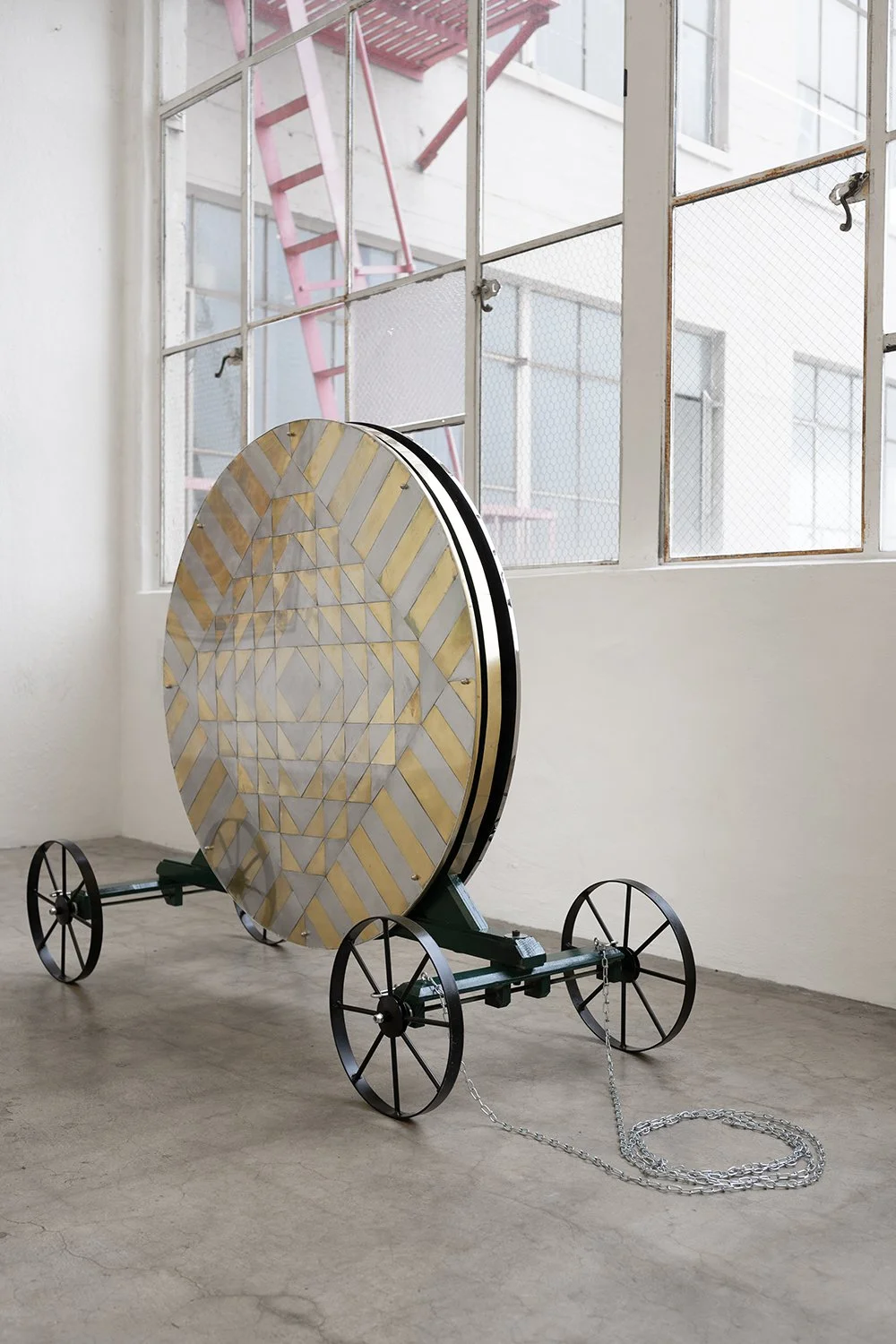






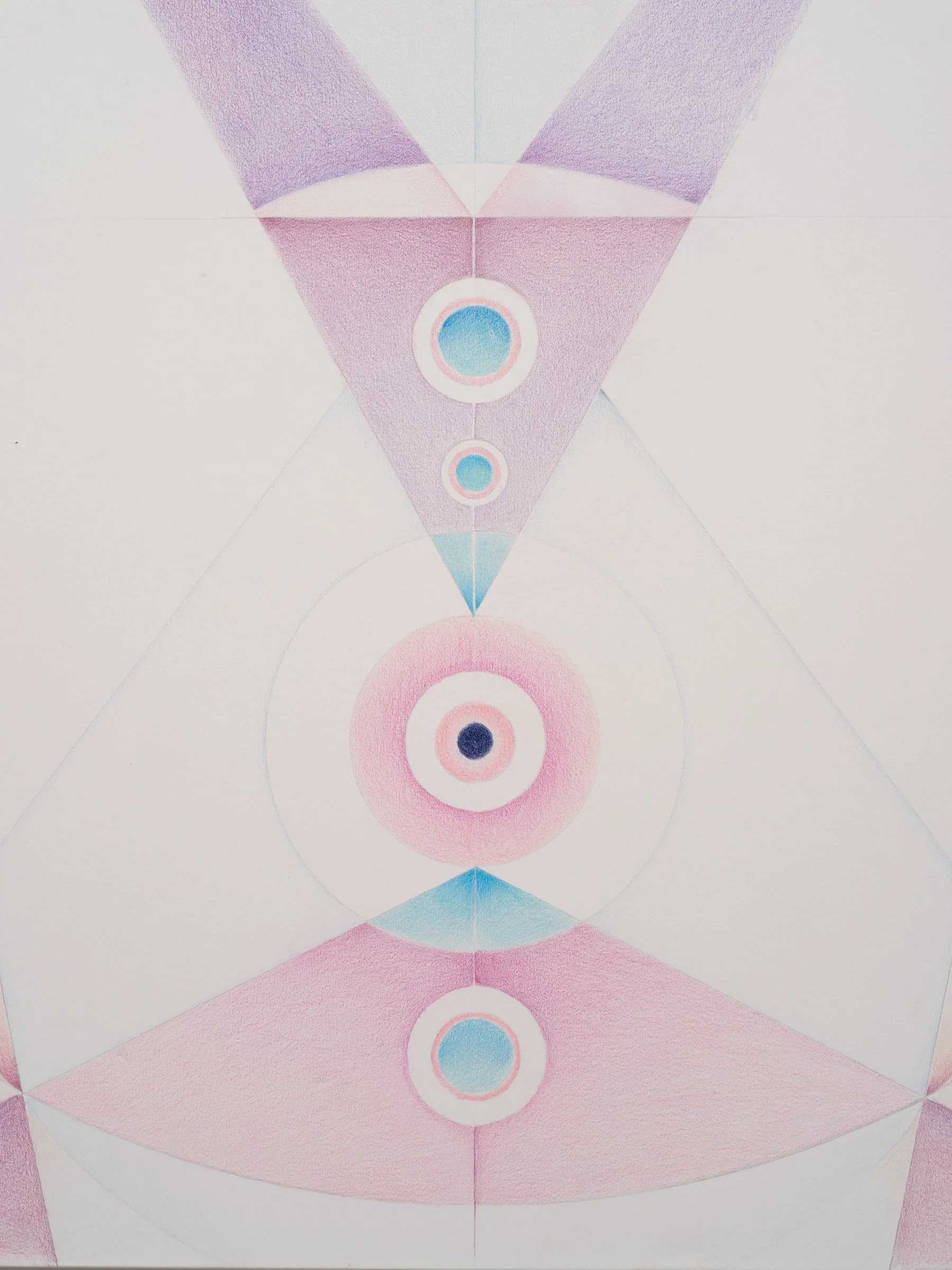





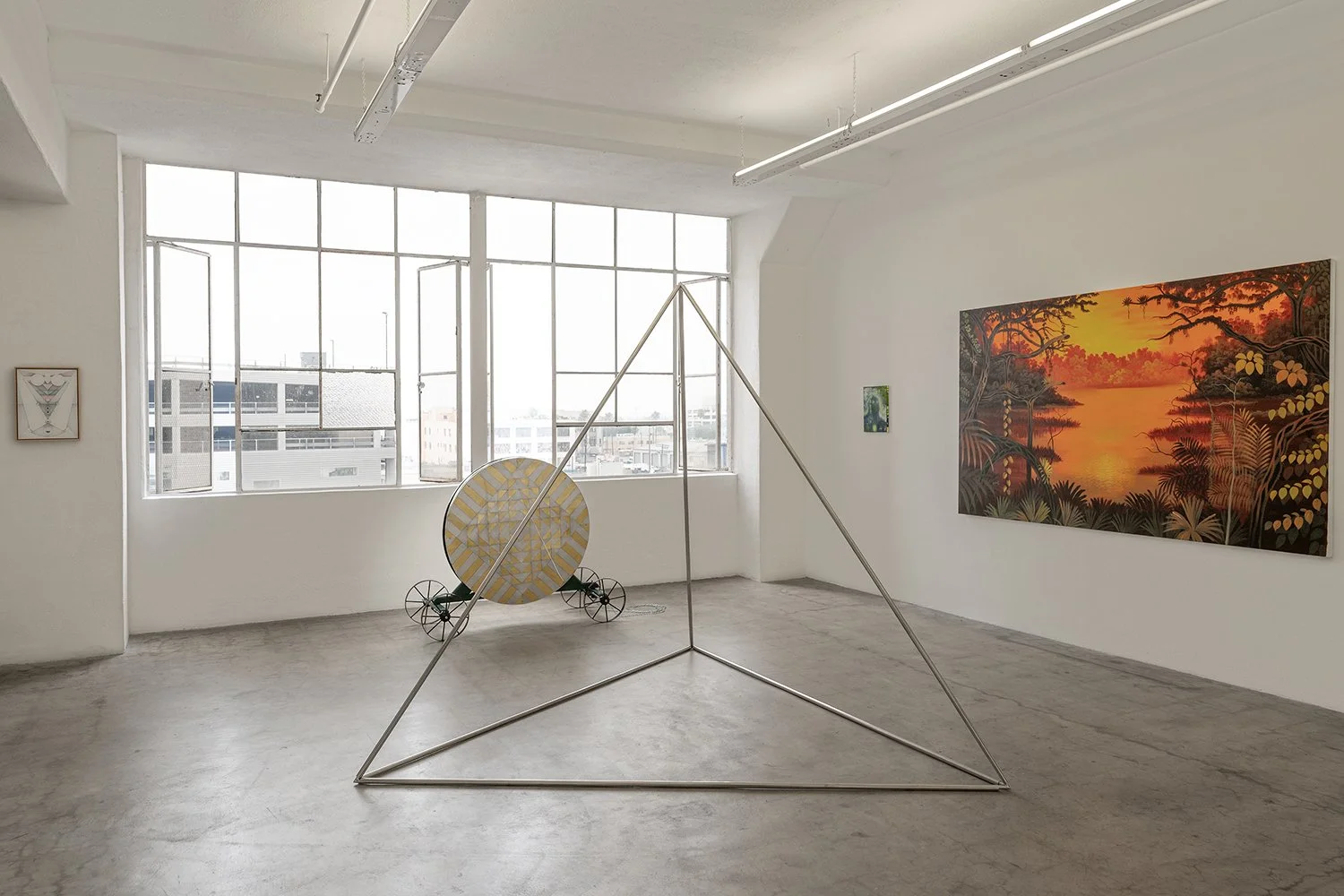
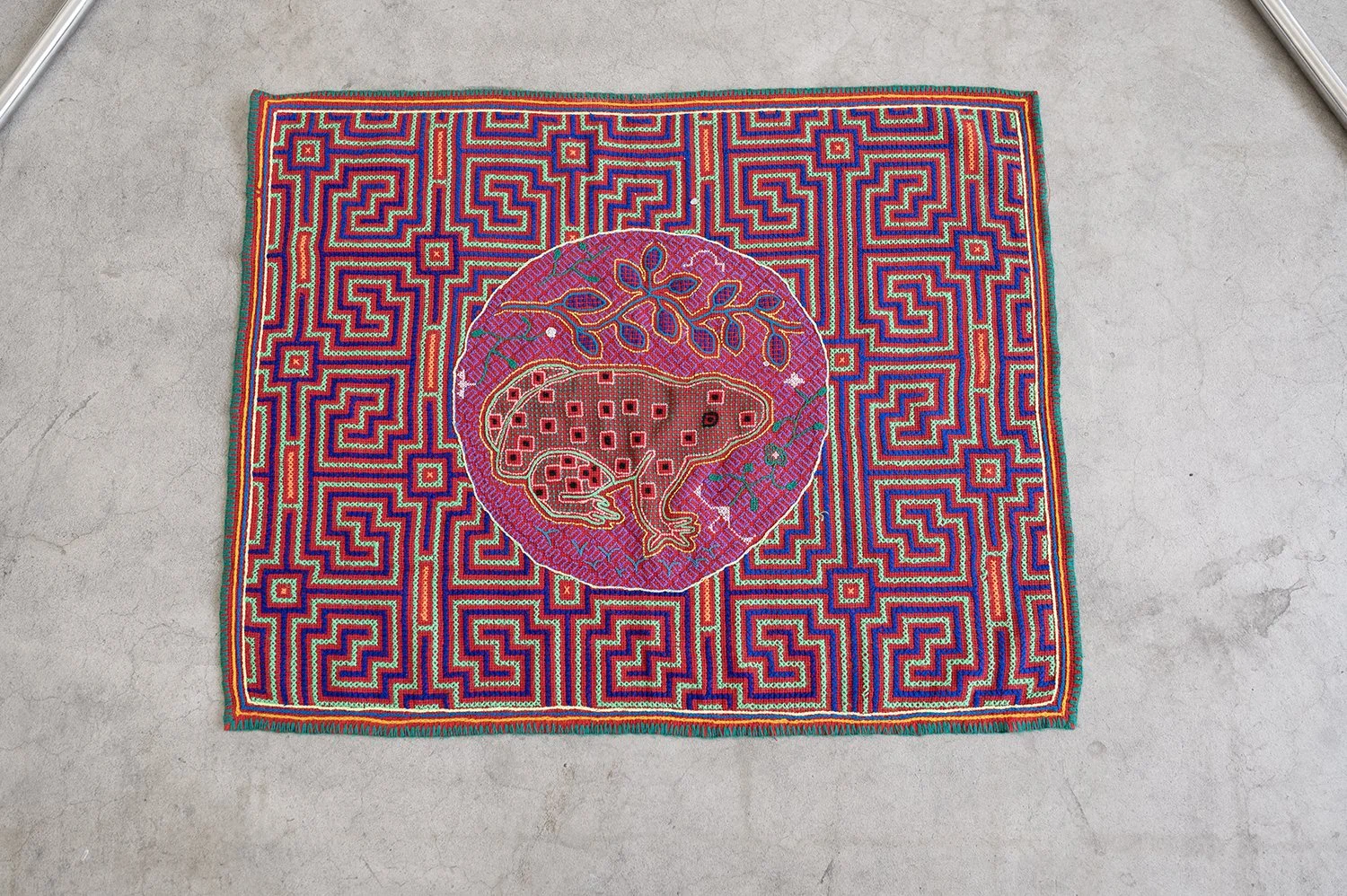

photos by Gemma Lopez & Ruben Diaz


